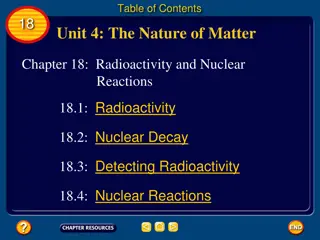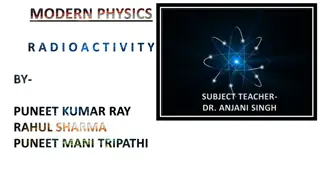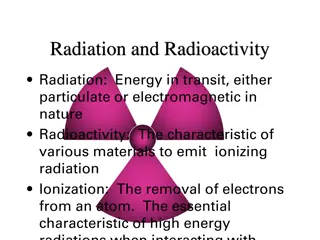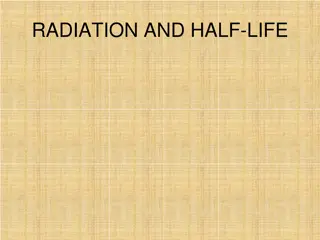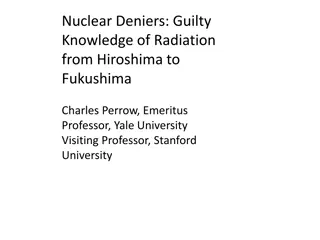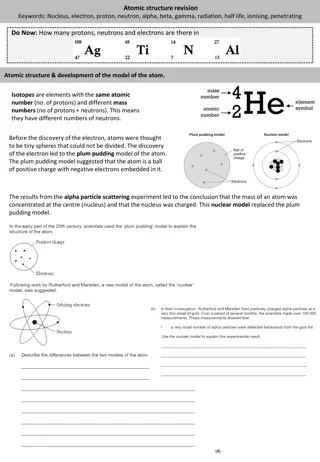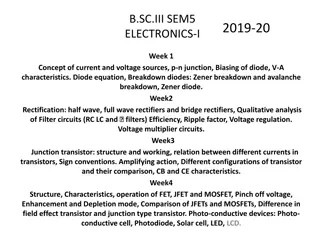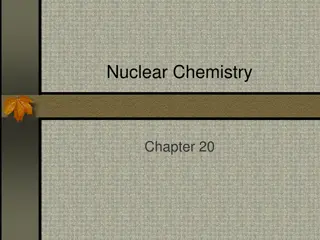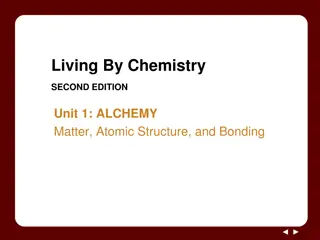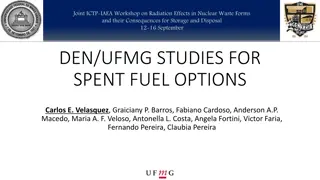Understanding Radioactivity and Nuclear Radiation
Radioactivity is the process in which unstable nuclei emit radiation, such as alpha, beta, or gamma particles, to become stable. This emission can change the element's identity and is crucial in fields like nuclear power and understanding Earth's core heat source. Different radioactive isotopes like uranium decay in unique ways, emitting specific particles. Alpha particles are massive and barely penetrate paper, beta particles travel faster and can pass through paper but are stopped by aluminum, and gamma rays are high-energy photons that pose health risks. Neutron radioactivity is also significant.
Download Presentation

Please find below an Image/Link to download the presentation.
The content on the website is provided AS IS for your information and personal use only. It may not be sold, licensed, or shared on other websites without obtaining consent from the author. Download presentation by click this link. If you encounter any issues during the download, it is possible that the publisher has removed the file from their server.
E N D
Presentation Transcript
9.1 What is Radioactivity? I can: -recognize the meaning of radioactive. -recognize that through radioactive decay, the unstable nucleus emits radiation in the form of very fast- moving particles and energy to produce a new nucleus, thus changing the identity of the element and nuclei that undergo this process are said to be radioactive. -construct a graph that shows that radioactive decay is unique and constant and use that graph to determine the half-life for a radioisotope.
Nuclear Radiation Radioactivity: the process by which an unstable nucleus emits one or more particles or energy in the form of electromagnetic radiation. (it just wants to become stable) Nuclear decay isotopes: different numbers of protons than neutrons. Nuclear Radiation: the particles that are released from the nucleus during radioactive decay. Do not confuse this with light radiation. Can be very harmful to the materials that absorb the radiation.
When a radioactive nucleus decays, the nuclear radiation leaves the nucleus.
Alpha particles (+) consist of protons and neutrons. Uranium is a radioactive element that occurs in 3 isotope forms. Energy source in nuclear power plants. U 234, U 235, U 238, U Responsible for most of the heat in Earth s core. U 238 undergoes nuclear decay by emitting positively charged particles (Rutherford) Alpha particles (2 protons and two neutrons He): positively charged atom that is released in the disintegration of radioactive elements and that consists of two protons and two neutrons. So massive they barely travel through a piece of paper. Pull electrons from other matter, thus losing energy as it passing through.
Beta particles (-) Travels through matter that alpha particles do not. Only released during certain types of radioactive decay. Fast moving When neutrons decay, they form a proton and electron. Electron has little mass and is ejected from nucleus at high speed Easily go through paper, but stopped by aluminum or wood. Like alpha particles, they ionize atoms which slows them down.
Gamma rays are very high energy More penetrating than beta particles Gamma ray: the high-energy photon emitted by a nucleus during fission and radioactive decay. Unlike beta and alpha, they are not made of matter. Photons Have more energy than light or X-rays Pose highest danger to health
Neutron radioactivity may occur in an unstable nucleus Neutron are not charged, therefore do not ionize matter. Can travel the furthest of all three previously mentioned forms of radioactivity.
Nuclear Decay When unstable nuclei emit alpha or beta particles, # of proton and neutrons change. Radium-226 Radium-222 A nucleus gives up two protons and two neutron during alpha decay A nucleus gains a proton and loses a neutron during beta decay.
Radioactive Decay Rates Half-life: the time required for half of a sample of a radioactive substance to disintegrate by radioactive decay. Parent v. daughter material (penny example)
Half-Life is a measure of how quickly a substance decays. (Fractions) ,1/4,1/8,1/16,1/32,1/64 Depends on stability of nucleus. Potassium-40=rocks Carbon-14=more recent materials
Half-life Practice The half-life of iodine-131 is 8.1 days. How long will it take for three-fourths of a sample of iodine-131 to decay? Radon-222 is a radioactive gas with a half-life of 3.82 days. How long would it take for fifteen-sixteenths of a sample of radon-222 to decay? Uranium-238 decays very slowly, with a half-life of 4.47 billion years. What percentage of a sample of uranium-238 would remain after 13.4 billion years?


